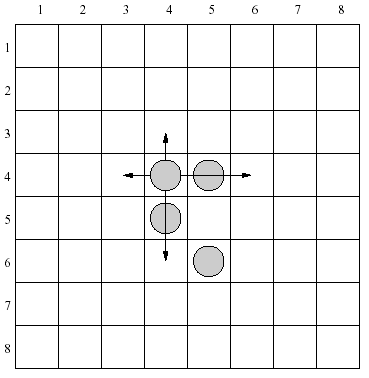Solitaire
Time Limit: 2000/1000 MS (Java/Others) Memory Limit: 65536/32768 K (Java/Others)
Total Submission(s): 2539 Accepted Submission(s): 826
There are four identical pieces on the board. In one move it is allowed to:
> move a piece to an empty neighboring field (up, down, left or right),
> jump over one neighboring piece to an empty field (up, down, left or right).

There are 4 moves allowed for each piece in the configuration shown above. As an example let's consider a piece placed in the row 4, column 4. It can be moved one row up, two rows down, one column left or two columns right.
Write a program that:
> reads two chessboard configurations from the standard input,
> verifies whether the second one is reachable from the first one in at most 8 moves,
> writes the result to the standard output.
respectively. Process to the end of file.
4 4 4 5 5 4 6 5 2 4 3 3 3 6 4 6
YES
唉,这题从昨晚调到现在,结果被自己一个sb错误坑了这么久,强烈bs一下自己。。。
题目大意:一个8*8的棋盘上面有4颗棋子,4颗棋子都一样。每颗棋子可以向周围4个方向移动,如果相邻的地方没有其他棋子,可以移动到相邻位置,如果相邻位置已经有棋子了,并且相邻位置的棋子同方向的相邻位置没有棋子,则也可以移动。具体看图就明白。现在给定初态和终态,判断8步内是否能从初态到终态。
题目分析:bfs。由于本题状态实在太多,单向bfs肯定会爆内存。而且本题给了终态,很自然想到dbfs。判重的话,由于有4颗棋子,所以状态非常多。没有想到比较好的判重方式。所以就开了一个4维数组判重。将每颗棋子的坐标化成一个0-63的整数,然后开一个四维数组判重。这样的代价比较大。然后就按照一般的dbfs开始写。写完交了几遍都MLE了。。。因为是同时从两边开始搜的,所以数组要开2个,一个数组的规模64^4大概在一千万以上,而且同时搜2个队列同时工作,空间开销非常之大。于是又重写了一下。这次用2次单向bfs,分别从起点和终点搜4步。开一个四维数组判重即可。具体做法是用2-5标识正向搜4步的所有到达的状态。7-10标识反向搜4步能到达的所有状态。0表示正反都未搜过。那么在搜索的时候如果正向搜,所有的状态标记上,反向搜的时候如果发现某个状态已经被标记了,检查标记是否小于6,如果是,则表明正向已经到达这个状态了,返回。如果正反4步都没搜到,返回。
昨晚调到今天,结果跪在了返回条件上。因为正向是从1开始搜的,要控制搜4步,那么出队的节点的step要<=5。。。少了2个等号。。。悲剧这么久。。。
这题还要注意的是判重的时候要对点的位置排序,因为移动后点的位置编号就乱了,很多情况是一个状态,如果步排序就会增加很多状态。
详情请见代码(还是比较臭比较长但是比较清晰):D
#include <iostream>
#include<cstdio>
#include<cstring>
#include<algorithm>
using namespace std;
const int N = 10005;//减掉2个0 62MS 16736K
char flag[64][64][64][64];
bool ok;
struct node
{
int pos[4];
char step;
}ss,now;
struct que
{
struct node t[N];
int head,tail;
void init()
{
head = tail = 0;
}
bool empty()
{
return tail == head;
}
struct node top()
{
return t[head];
}
void push(struct node a)
{
t[tail] = a;
tail ++;
if(tail >= N)
tail -= N;
}
void pop()
{
head ++;
if(head >= N)
head -= N;
}
}q;
bool find(int x)
{
int i;
for(i = 0;i < 4;i ++)
if(ss.pos[i] == x)
return true;
return false;
}
void bfs(int time)
{
int i;
while(!q.empty())
{
now = q.top();
if(!time && now.step >= 5)//!!!不加等号就会多搜一步
{
return;
}
if(time && now.step >= 10)//!!!
{
return;
}
q.pop();
for(i = 0;i < 4;i ++)
{
ss = now;
ss.step ++;
if(ss.pos[i] >= 8 && !find(ss.pos[i] - 8))//up
ss.pos[i] -= 8;
else
{
if(ss.pos[i] >= 16 && !find(ss.pos[i] - 16) && find(ss.pos[i] - 8))
ss.pos[i] -= 16;
}
sort(ss.pos,ss.pos + 4);
if(!flag[ss.pos[0]][ss.pos[1]][ss.pos[2]][ss.pos[3]])
{
flag[ss.pos[0]][ss.pos[1]][ss.pos[2]][ss.pos[3]] = ss.step;
q.push(ss);
}
else
{
if(time && flag[ss.pos[0]][ss.pos[1]][ss.pos[2]][ss.pos[3]] < 6)
{
ok = true;
return;
}
}
ss = now;
ss.step ++;
if(ss.pos[i] <= 55 && !find(ss.pos[i] + 8))//down
ss.pos[i] += 8;
else
{
if(ss.pos[i] <= 47 && !find(ss.pos[i] + 16) && find(ss.pos[i] + 8))
ss.pos[i] += 16;
}
sort(ss.pos,ss.pos + 4);
if(!flag[ss.pos[0]][ss.pos[1]][ss.pos[2]][ss.pos[3]])
{
flag[ss.pos[0]][ss.pos[1]][ss.pos[2]][ss.pos[3]] = ss.step;
q.push(ss);
}
else
{
if(time && flag[ss.pos[0]][ss.pos[1]][ss.pos[2]][ss.pos[3]] < 6)
{
ok = true;
return;
}
}
ss = now;
ss.step ++;
if(ss.pos[i] % 8 && !find(ss.pos[i] - 1))
ss.pos[i] -= 1;
else
{
if(ss.pos[i] % 8 > 1 && !find(ss.pos[i] - 2) && find(ss.pos[i] - 1))
ss.pos[i] -= 2;
}
sort(ss.pos,ss.pos + 4);
if(!flag[ss.pos[0]][ss.pos[1]][ss.pos[2]][ss.pos[3]])
{
flag[ss.pos[0]][ss.pos[1]][ss.pos[2]][ss.pos[3]] = ss.step;
q.push(ss);
}
else
{
if(time && flag[ss.pos[0]][ss.pos[1]][ss.pos[2]][ss.pos[3]] < 6)
{
ok = true;
return;
}
}
ss = now;
ss.step ++;
if((ss.pos[i]) % 8 != 7 && !find(ss.pos[i] + 1))
ss.pos[i] += 1;
else
{
if(ss.pos[i] % 8 < 6 && !find(ss.pos[i] + 2) && find(ss.pos[i] + 1))
ss.pos[i] += 2;
}
sort(ss.pos,ss.pos + 4);
if(!flag[ss.pos[0]][ss.pos[1]][ss.pos[2]][ss.pos[3]])
{
flag[ss.pos[0]][ss.pos[1]][ss.pos[2]][ss.pos[3]] = ss.step;
q.push(ss);
}
else
{
if(time && flag[ss.pos[0]][ss.pos[1]][ss.pos[2]][ss.pos[3]] < 6)
{
ok = true;
return;
}
}
}
}
}
int main()
{
int a,b;
int i;
while(scanf("%d%d",&a,&b)!= EOF)
{
ss.pos[0] = (a - 1) * 8 + b - 1;
for(i = 1;i < 4;i ++)
{
scanf("%d%d",&a,&b);
ss.pos[i] = (a - 1) * 8 + b - 1;
}
memset(flag,0,sizeof(flag));
sort(ss.pos,ss.pos + 4);
flag[ss.pos[0]][ss.pos[1]][ss.pos[2]][ss.pos[3]] = 1;
ss.step = 1;
q.init();
ok = false;
q.push(ss);
bfs(0);
for(i = 0;i < 4;i ++)
{
scanf("%d%d",&a,&b);
ss.pos[i] = (a - 1) * 8 + b - 1;
}
sort(ss.pos,ss.pos + 4);
ss.step = 6;
if(flag[ss.pos[0]][ss.pos[1]][ss.pos[2]][ss.pos[3]])
{
printf("YES\n");
continue;
}
else
flag[ss.pos[0]][ss.pos[1]][ss.pos[2]][ss.pos[3]] = 6;
q.init();
q.push(ss);
bfs(1);
if(ok)
printf("YES\n");
else
printf("NO\n");
}
return 0;
}
//78MS 16740K